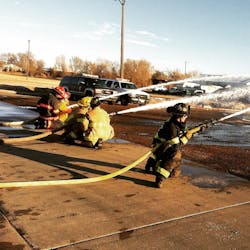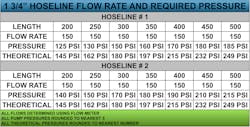It is every firefighter’s duty to understand the capabilities and limitations of the hoselines that they use. There are many manufacturers that produce hoselines for the fire service, and not all hoselines perform the same. With multiple sizes available, every firefighter must understand the performance characteristics of each hoseline and which hoseline to use for each incident.
Effective working length
One of the most important capabilities/limitations of an attack hoseline is the effective working length, which is the maximum length the hoseline can be stretched and continue to produce the target flow rate. This will vary based on the hoseline itself (as the performance characteristic of each model of hoseline varies) and the nozzle that is being used. Each fire department must determine what it considers to be a manageable hoseline; some may consider it a hoseline with a pump pressure of 160 psi or less while another may be comfortable with 185 psi or less. Each of these characteristics will impact the effective working length of the hoseline.
The construction of each model of hoseline varies in some way, including the internal diameter size, which may differ even on hoselines that are labeled the same size. As a result, the performance characteristics of each model varies, especially in regards to the amount of pressure that is lost due to friction loss in the hoseline. Friction loss is the primary limiting factor in the effective working length of a hoseline. It is important for firefighters to understand the friction loss characteristics of each hoseline in use within their department. For example, one manufacturer in particular produces multiple models of 1¾-inch hoselines. The friction loss coefficient of these models vary from 7.0 to 11.5. As the friction loss coefficient varies so does the amount of pressure that will be lost. A hoseline operation using the hose with a friction loss of 7.0 will forfeit less pressure than the other, and will therefore have an effective working length that exceeds the effective working lengths of the hoselines with the higher friction loss coefficient.
Nozzle selection
Nozzles are another factor in determining the effective working length of the hoseline. There are four categories of nozzles (smooth-bore, fixed-gallonage fog, selectable-gallonage fog and automatic nozzles), and each category has various models to choose from. While the effective working length of the hoseline is not impacted by the type of nozzle being used, it is impacted by the nozzle pressure required to produce an effective fire stream.
Smooth-bore nozzles on handlines require a nozzle pressure of 50 psi. The required nozzle pressure of fixed-gallonage fog nozzles varies based on the design. Some fixed-gallonage fog nozzles will have a fixed-nozzle pressure requirement, while others possess removable discs that adjust the nozzle pressure requirement of the nozzle from 100 psi down to 50 psi. When nozzles with adjustable discs are being used, the firefighter must know which disc is being used in the nozzle at the time. Selectable-gallonage nozzles will require a nozzle pressure of either 75 psi or 100 psi. Many automatic nozzles will require a nozzle pressure of 100 psi while some “low-pressure” automatic nozzles will only require a nozzle pressure of 75 psi. Firefighters must understand the requirements of the nozzle that they are using, as the nozzle pressure requirement of the nozzle will impact the effective working length of the hoseline being used. As the nozzle pressure requirement decreases, the amount of pressure available to extend the length of the hoseline increases.
Flow tests are key
Firefighters should train with, as well as flow test, any hoseline/nozzle combination that they may utilize in order to understand the capabilities and limitations of each hoseline/nozzle setup. As hoselines and nozzles are changed, the effective working length of the hoseline as well as the flow rate from the nozzle may change. It is important that firefighters understand these changes to ensure that they do not attempt to exceed the capabilities of the hoseline/nozzle combination that they are using.
A good test is to take two 200-foot, 1¾-inch hoselines of different models that were both produced by the same manufacturer, and a 150-gpm at 75 psi fixed-gallonage fog nozzle. Both nozzles should include an inline pressure gauge and a flow meter to ensure proper nozzle pressure and flow rate, one hoseline required a pump pressure of 125 psi while the other hoseline required a pump pressure of 140 psi. While both hoselines are considered to be manageable hoselines at these pressures, and therefore within the effective working length of the hoseline, the difference between the capabilities and limitations can be seen when the lengths of the hoselines are increased. In this case, 170 psi was determined to be the upper limit of a manageable hoseline and anything above 170 psi was determined to be exceeding the effective working length. The first hoseline was able to reach 400 feet while producing the 150 gpm target flow rate of the nozzle at a pump pressure of 170 psi. At 400 feet, the second hoseline required a pump pressure of 190 psi to achieve the 150 gpm target flow rate. In order to meet the effective working length requirement of 170 psi or less, the second hoseline was limited to 300 feet (see Figure 1). This is information that should be known by every firefighter. It is important for every fire department to determine what they consider to be a manageable hoseline for their individual fire department as well as determine the effective working length of the hoselines that they use.
These flow tests provide firefighters with practical information regarding the hoselines to accompany the technical information provided by the manufacturer. The manufacturer provides technical specifications, including the friction loss coefficient and the amount of friction loss in each 50-foot section for that model of hoseline. Using this information, firefighters can calculate the theoretical pump pressure needed for the hoseline to achieve the target flow rate of the nozzle being used. By performing the flow tests, firefighters will learn the pump pressures needed for the hoseline to produce the target flow rate of the nozzle being used under real-world practical circumstances. Firefighters will observe that the theoretical numbers and the practical numbers will not always match.
The flow test described earlier was performed on each of the 1¾-inch hoselines at lengths from 200 to 500 feet, in increments of 50 feet, to determine the pump pressures required to flow the 150-gpm target flow rate of the nozzle selected using that engine company’s apparatus, hoseline and nozzle. During every one of the 14 flow tests that were performed, the pump pressure that was required during the flow test using both an inline pressure gauge and a flow meter was less than the required pressure stated by the theoretical calculation using the coefficient formula, which lists 1¾-inch hoselines as having a friction-loss coefficient of 15.5.
In sum
Understanding the true real-world practical requirements, capabilities and limitations of the hoseline is invaluable to the firefighter. It is the responsibility of every firefighter to ensure that they understand all of their equipment, including hoselines.
About the Author

Anthony Rowett Jr.
ANTHONY ROWETT Jr. is a captain with the Mobile, AL, Fire Rescue Department. He was previously a firefighter with the Ogdensburg, NJ, Fire Department. Rowett has an associate’s degree in fire science technology from County College of Morris, NJ, a bachelor’s degree in fire science, and a master’s degree in emergency services management. He is a contributing author for multiple fire service publications and has presented at multiple fire service conferences. He has also served as a lead HOT instructor for a hoseline operations class at the Metro Atlanta Fire Fighters Conference. Rowett is the founder of Port City Fire Training. He can be reached at [email protected].

